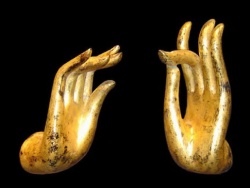Mudra
Mudrā; (Tib. phyag rgya). Literally “hand seal”.
Mudrās are religious and occult signs made with the fingers, as for instance the various hand gestures of the Buddha depicted in Buddhist art.
They symbolize different aspects of the teachings, and are often all that is needed to distinguish one type of Buddha from another.
“Mudra, a Sanskrit word, once meant a seal or its impression, so, when applied to a gesture performed by a priest, it was a guarantee of the efficacy of a rite, rather like the Christian sign for absolution.
The mudra is first seen in Indian art in images of Shakyamuni, the historical Buddha, about the 2nd century AD.
By the 7th century, mainly due to the influence of Tantrism, a wide range of gestures had been established, each with its own precise meaning, and holding latent magical powers.
In this form they spread east with Buddhism to Tibet, China, Indonesia, and Japan”
The term mudras derived from the root mud, "to please," and in its upasana Form is so called because it gives pleasure to the Devas.
Devanang moda-da mudra tasmat tang yatnatashcharet.
It is said that there are 108, of which 55 are commonly used.
The term means ritual gestures made with the hands in worship or positions of the Body in yoga practice.
Thus of the first class the matsya – (fish) mudra is formed in Offering arghya by placing the right hand on the back of the left and extending, fin-like, on each side the two thumbs, with the object that the Conch which contains water may be regarded as an ocean with aquatic Animals;
and the yoni-mudra which presents that organ as a triangle formed by the thumbs, the two first fingers, and the two little fingers is shown with the object of invoking the Devi to come and take Her place before the worshipper, the yoni being considered to be Her pitha or yantra.
The upasana mudra is thus nothing but the outward expression of inner resolve which it at the same time intensifies.
Mudra are employed in worship (archchana) japa, Dhyana (q.v.), kamya-Karma (rites done to effect particular objects), pratishtha (q.v.), snana (bathing), avahana (welcoming), naivedya (Offering of Food), and visarjana, or dismissal of the Devata.
Some mudra of hatha yoga are described sub voc. "Yoga."
The Gheranda Sanghita says that Knowledge of the yoga mudras grants all Siddhi, and that their performance produces physical benefits such as stability, firmness and cure of disease.
